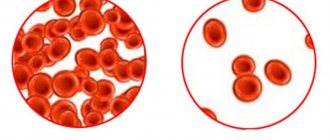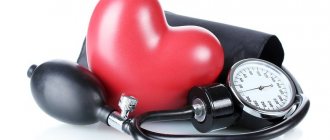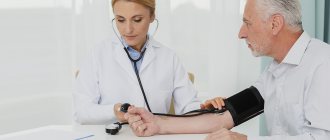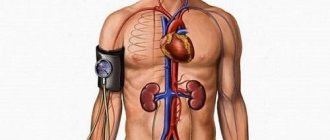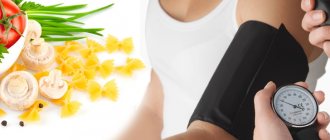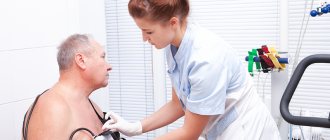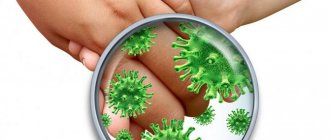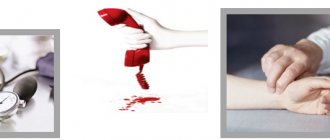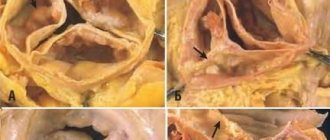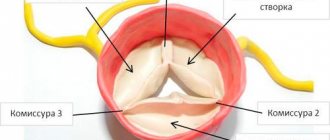ATTENTION! From January 2022, a new medical center will open for you at the address: Dmitrovskoye Shosse, 81 (5 minutes walk from the Selegerskaya metro station), where you can receive a wide range of medical services, including CT (computer tomography).
- home
- Therapy
- Treatment of arterial hypotension
Arterial hypotension is a less dangerous condition compared to hypertension. Hypotension, as it is also called in medicine, is characterized by a regular decrease or persistent low blood pressure, when the systolic (upper) scale does not exceed 100 mm Hg, and the diastolic (lower) 60 mm. rt. Art. Below you will find out what the causes of hypotension are, the symptoms and how the disease is treated.
Description of the disease
Hypotension may be hereditary or hereditary due to predisposition. This is the primary physiological type of the disease. Secondary hypotension can be caused by a number of other diseases of the patient - hepatitis, ulcerative conditions of the gastrointestinal tract, cirrhosis of the liver, or develop as a result of side effects of certain medications or taking medicinal herbs.
The disease is diagnosed most often in women 30-40 years old, in whom mental work predominates, as well as in athletes who play sports professionally. A decrease in pressure may occur during climate change, which is temporary.
And although arterial hypotension against the background of other cardiovascular diseases does not pose a serious danger to human life, it significantly reduces the quality of life, causes a lot of inconvenience and prevents the patient from leading a normal life. Hypotension should be treated in the same way as other diseases of the cardiovascular system, without ignoring the symptoms and without waiting for complications.
Treatment rules
Treatment of arterial hypotension can begin only after the real reasons for the decrease in pressure have been established. If a patient is diagnosed with primary pathological arterial hypotension, then he will be prescribed symptomatic therapy to normalize/stabilize the vegetative-vascular system. In case of secondary pathological hypotension, the main thing is the treatment of the underlying disease, and if it is carried out correctly, then the patient’s blood pressure will quickly normalize/stabilize.
Drug therapy for this condition necessarily includes the following drugs:
- nootropic drugs;
- of plant origin - tinctures of ginseng or lemongrass root;
- tranquilizers or antidepressants;
- anticholinergics;
- cerebroprotectors;
- vitamin complexes, antioxidants.
Once the patient’s condition has stabilized and there is no risk of complications due to low blood pressure, a course of non-drug therapy can be carried out. As part of this treatment, doctors prescribe:
- massage;
- various water procedures - for example, contrast showers, hydromassage, baths;
- aromatherapy;
- electrophoresis on the collar area;
- electrosleep;
- acupuncture;
- reflexology;
- physical therapy.
Such non-drug treatment, as a rule, is carried out in specialized sanatoriums and dispensaries, and chronic hypotension requires regular repeated courses of such therapy.
Please note: acute hypotension is a fairly dangerous situation and requires immediate medical attention! Treatment can be prescribed and carried out only by a specialist doctor.
Causes and treatment of hypotension
There are some factors that provoke low blood pressure in a person. The main causes of hypotension are:
- Pregnancy. In women during this period, vascular tone decreases, which affects her blood pressure and hypotension may develop.
- Adaptation to a new climate or new living conditions. Cold and high humidity can adversely affect human health and cause a temporary or permanent decrease in blood pressure.
- Diseases of the cardiovascular system. Heart failure, arrhythmia, atherosclerosis, and aortic valve stenosis lead the patient to hypotension.
- Decreased immunity. Lack of vitamins in the body: groups B, C, E.
- Gastrointestinal diseases. Ulcerative lesions of the stomach, duodenum, intoxication.
- Neurological pathologies. VSD, fatigue, neuroses, overwork, depression.
- Excessive physical activity. Hypotension is observed in athletes against a background of exhaustion as a protective reaction of the body.
Chronic hypotension, in particular of the diastolic type, should be treated by a doctor. Our clinic will help each patient diagnose the disease, its causes and prescribe competent treatment.
Preventive actions
There is no specific prevention of hypotension, but the risk of its development can be reduced by following a diet, work and rest schedule, physical education, regular preventive examinations, avoiding the consumption of alcoholic beverages and treatment of underlying somatic diseases.
When the first signs of arterial hypotension appear, you should seek medical help. You can use the CELT clinic, which has experienced cardiologists who can not only make a diagnosis and find out the causes of hypotension, but also provide comprehensive treatment.
Make an appointment through the application or by calling +7 +7 We work every day:
- Monday—Friday: 8.00—20.00
- Saturday: 8.00–18.00
- Sunday is a day off
The nearest metro and MCC stations to the clinic:
- Highway of Enthusiasts or Perovo
- Partisan
- Enthusiast Highway
Driving directions
Symptom and treatment of hypotension
The main symptom of the disease is a decrease in blood pressure from 90/60 mmHg. and below.
Doctors and patients distinguish the following symptoms of hypotension:
- Fatigue, weakness, weariness.
- Lack of strength, apathy, drowsiness.
- Dizziness.
- Fainting and faintness, noise in the ears and darkness in the eyes.
- Headache.
- Irritability, nervousness.
- Feeling of squeezing and heaviness in the heart area.
- Sudden change of mood.
- Disorders of the menstrual cycle in women and potency in men.
- Impaired memory and concentration.
- Excessive sweating of the feet and palms.
- Yawning due to lack of oxygen, nausea and gastrointestinal dysfunction.
Hypotension in pregnant women is treated under the supervision of an obstetrician-gynecologist. Hypotension in the elderly is treated by specialized specialists. In our clinic, general practitioners and cardiologists provide qualified care and accompany the patient’s medical history until the patient’s complete recovery.
When there is nowhere lower. Understanding the causes of hypotension
A feeling of “lightheadedness” after a stuffy bus, fatigue after a long night’s sleep, “goosebumps” before the eyes after abruptly getting out of bed... These and other symptoms may indicate a decrease in blood pressure - hypotension. And if numerous studies have been devoted to hypertension and treatment principles have been well developed, then with hypotension not everything is so obvious.
What is it, what causes it, how is it recognized and treated? We are talking about this with our permanent consultant, general practitioner, cardiologist at Clinic Expert Voronezh, Kalinina Angelina Anatolyevna.
— Angelina Anatolyevna, what is hypotension? Is this a diagnosis or a syndrome?
Hypotension is low blood pressure. It can be either just a symptom or a diagnosis.
What does “low blood pressure” mean? This is a condition in which blood pressure numbers are lower than expected for a person in a given situation. And what’s interesting: even if the pressure dropped by 20-30 mmHg. and at the same time remained within the normal range, but the person began to feel worse, then this condition can also be regarded as hypotension.
Read the material on the topic: What should a child’s blood pressure be?
Hypotension can be physiological or pathological. Physiological is a variant of the norm. It may, for example, occur in trained athletes, people living in high mountains or hot climates.
Pathological hypotension. These include essential (or primary) hypotension (hypotonic disease), symptomatic (or secondary) hypotension, as well as idiopathic orthostatic hypotension.
Below normal is:
blood pressure below 100/60 mm Hg. Art. in men and 95/60 mm Hg. Art. among women
according to other data - pressure below 100/60 mmHg. in people under 25 years of age, and below 105/65 mmHg. - over 30 years old
The most common pathological condition is essential hypotension. It is expressed by a steady decrease in blood pressure with characteristic manifestations.
Secondary hypotension is a consequence of another disease or drug use.
— What is low blood pressure? At what numbers can we say that the pressure is below normal?
According to some data, blood pressure is below 100/60 mm Hg. Art. in men and 95/60 mm Hg. Art. among women; according to others - pressure below 100/60 mmHg. in people under 25 years of age, and below 105/65 mmHg. - over 30 years old. Moreover, hypotension is said to occur when both indicators (“upper” and “lower” pressure) or one of them decrease.
— High blood pressure threatens a heart attack or stroke. Why is low blood pressure dangerous?
There is an opinion that with an excessive decrease in blood pressure there is also a risk of developing cardiovascular complications, although studies with the required level of evidence have not been conducted.
With age, hypotension may disappear, giving way to arterial hypertension.
In most cases, the prognosis is favorable. If there are no complaints related to low blood pressure, and the person is adapted to it, then hypotension does not cause much harm to the body.
Read the material on the topic: Spinning until you drop! Why do you get dizzy?
The concern is the progression of the disease, repeated episodes of fainting (and possible falls associated with them), the presence of other concomitant pathologies (coronary heart disease, diabetes mellitus, etc.), as well as the patient’s advanced age (risk of falls, deterioration of blood supply to the brain).
— At what blood pressure levels should you urgently call a doctor? Where is the lowest limit?
Everything here is individual. Those. pressure that is low for one may be normal for another (especially if we are talking about hypotension). Therefore, it is quite difficult to voice the limit of the lowest norm.
However, if the patient has symptoms indicating the development of a threatening condition (pain in the heart or chest, shortness of breath, arrhythmic pulse, vomiting, convulsions, impaired consciousness), this is a reason to call an ambulance with possible hospitalization.
— What does a person experience with low blood pressure? What are the symptoms of hypotension?
The most common manifestations of hypotension are general weakness, fatigue, headaches, a tendency to dizziness, pre- and fainting states. There may also be irritability and deterioration in performance (which, with essential hypotension, is often noted already in the morning). Poor tolerance to transport, stuffiness, heat, movement on an escalator, staying at heights. Nausea, impaired thermoregulation (“chilliness”), sweating, fluctuations in blood pressure - from low to high). Difficulty absorbing information, sleep disorders, noise in the head.
Meteorological conditions, etc. may be reported.
Read material on the topic: What is weather dependence: diagnosis or fiction?
Symptoms of hypotension are more common in young, thin women. They often experience anxiety and low mood.
When collecting anamnesis, hereditary burden may be revealed, i.e. existing or existing cases of low blood pressure in the family.
— What leads to the development of hypotension? For what reasons does this condition develop?
The mechanisms of development of essential hypotension are not fully understood. There are suggestions that it is based on a violation of the so-called neuro-humoral regulation of blood circulation. Hereditary burden is often traced, usually through the female line.
There are many causes of secondary hypotension. It can occur when:
- some endocrine pathologies (reduced function of the thyroid gland - hypothyroidism, adrenal cortex - Addison's disease, autonomic diabetic neuropathy, weakened function of the anterior pituitary gland);
— diseases of the cardiovascular system (heart rhythm disturbances; mitral valve prolapse; pericarditis; heart defects; heart failure; coronary heart disease);
Read material on the topic: Coronary heart disease: diagnosis and treatment
— infections and intoxications;
- shock of various nature;
— neurological pathologies (traumatic brain injury and its consequences; brain tumors; syringomyelia, etc.);
- prolonged bed rest;
- pregnancy;
- lack of fluid;
- allergic reactions;
- taking various medications (psychotropic - antidepressants, anti-anxiety drugs, for the treatment of insomnia; antiarrhythmic; antihypertensive - reducing high blood pressure; diuretics; for the treatment of ischemia; anesthetics).
— Can hypotension turn into hypertension? Under what conditions can this happen?
Yes. With age, hypotension may disappear, giving way to arterial hypertension. Usually the pressure does not increase too much, but is nevertheless poorly tolerated. Moreover, it is even possible when the pressure numbers are still within the normal range (for example, the upper 130-135 mmHg) and cannot even be formally formulated as hypertension.
Read the material on the topic: It's off scale! Looking for reasons for high blood pressure
However, in a “past” hypotensive patient, they can already cause manifestations of classic arterial hypertension: a feeling of “pulsation” in the head, dizziness, redness of the face, nausea, rapid heartbeat. And this condition may require appropriate treatment (of course, with a very careful individual selection of drugs and dosages).
— What diagnostics do you need to undergo for hypotension in order to identify the cause of low blood pressure?
When diagnosing arterial hypotension, a general analysis of blood and urine is performed, some biochemical parameters are examined (including glucose), blood electrolytes, cortisol, thyroid hormones, ultrasound of the heart and thyroid gland, ECG, and 24-hour blood pressure monitoring are performed.
Read material on the topic: Ultrasound of the heart: when is it prescribed and what will it show?
Other ultrasound, as well as X-ray examinations, fibrogastroduodenoscopy - according to indications.
— It is known that doctors recommend keeping a diary for hypertensive patients. Is it necessary to keep the same diary for hypotensive patients?
Yes, it makes sense.
— Is hypotension treated with medication?
Yes, such treatment exists, but there are not many drugs. Some of them have shown themselves to work well in cases of orthostatic hypotension and essential hypotension with a “smooth”, monotonous course.
In practice, they are used relatively rarely and very carefully.
— What folk methods can help a hypotensive person raise their blood pressure? Do coffee, ginseng or eleutherococcus help with hypotension?
There are a number of studies showing a moderate positive effect on hypotensives of tea, coffee, as well as medications containing caffeine.
More of our articles in the company’s official VKontakte group
Ginseng or Eleutherococcus will also be effective to some extent, but their effect has not been fully studied - there is also no evidence base for them, as well as for the drugs mentioned above.
— Angelina Anatolyevna, what rules and recommendations should a hypotensive patient follow in order to improve the quality of their life and not feel overwhelmed and tired?
It is necessary to try to identify factors that cause a decrease in pressure and try to avoid/exclude them. Among them is sudden standing up (to prevent a decrease in pressure for this reason, you must first sit down, bend over, then raise your body and head, and stand up); long stay in an upright position; being in stuffy rooms, high air temperature; physical work, especially in hot conditions, as well as the possible loss of fluid associated with this (therefore it is necessary to control fluid loss).
You need to get enough rest, sleep, and follow a work schedule.
The diet (or, rather, the principles of nutrition) for hypotension consists of frequent meals in small portions, limiting the intake of hot food and drinks; foods rich in easily digestible carbohydrates. You can increase your salt and liquid intake (up to 2–2.5 liters of liquid, 8–10 g of salt per day).
Read material on the topic: Life without meat: food, philosophy or benefits for the body?
People with hypotension should avoid alcoholic beverages. Carefully monitor the intake of any medications, and be sure to warn your doctor about your tendency to low blood pressure.
It is imperative to look for and treat pathologies in which hypotension is secondary, i.e. is one of the manifestations of the underlying disease.
There are special gymnastics aimed at training vascular tone. Its principle is that a person who is in a horizontal position is transferred to a vertical position for a short time. The pressure decreases at this time. Such cycles are repeated, and the vessels gradually “get used” to maintaining the pressure at the proper level, which is especially important if you are prone to fainting. Such gymnastics should only be performed under the supervision of a qualified specialist.
You may also be interested in:
Why is electroencephalography needed? Complete patient guide
What is hidden behind the diagnosis of dyscirculatory encephalopathy?
Vegetative-vascular dystonia: go there - I don’t know where, cure that - I don’t know what
For reference:
Kalinina Angelina Anatolevna
In 2007 she graduated from the Voronezh State Medical Academy named after. Burdenko.
From 2007 to 2008 she completed an internship in therapy, in 2010 she underwent professional retraining in the specialty “General Medical Practice (Family Medicine)”, and in 2017 – in the specialty “Cardiology”.
Since 2015, he has held the position of general practitioner at Clinic Expert Voronezh. Reception is conducted at the address: st. Pushkinskaya, 11.
Drug treatment of hypotension
Many patients with hypotension use short-term treatments. This is drinking strong tea or coffee, chocolate, taking pills to raise blood pressure. But the very next day the pressure drops again, and the state of health worsens. Such measures can lead the patient to a chronic condition, and as a result, the development of complications. The patient wastes time temporarily eliminating symptoms.
It is important to approach treatment correctly. In our clinic, each patient has an individual approach, treatment is prescribed taking into account the patient’s medical history and in accordance with the latest protocols for the treatment of diseases as recommended by WHO.
- Nootropic drugs. Vinpocetine, Nootropil, Phenibut, Cinnarizine, etc.
- Drugs to normalize brain activity. Glycine, Cerebrolysin, etc.
- Other drugs to normalize blood pressure. Gutron, Ecdisten, Heptamil, Rantarin, etc.
The main medications prescribed for hypotensive patients are Askofen, Pyramein, Saparal, Citramon, etc. If there is an excess of caffeine, the patient may experience a rapid pulse, increased frequency of urination, anxiety and restlessness. Therefore, it is important to follow the doctor’s recommendations and not self-medicate.
How does hypotension manifest?
Doctors note that physiological hypotension almost never causes discomfort to a person; even the most characteristic symptoms are absent. Acute arterial hypotension occurs in a completely different way:
- a person may complain of dizziness, weakness and increased drowsiness;
- the skin becomes pale;
- Pre-fainting and loss of consciousness are possible.
The chronic form of pathological hypotension also has characteristic symptoms:
- constant headaches, fatigue, drowsiness;
- increased sweating;
- memory impairment;
- constant feeling of cold, chilliness;
- the heartbeat becomes rapid.
Secondary pathological hypotension is manifested by all of the above symptoms, but along with them there are also signs of the underlying disease.
Recommendations and prevention
Doctors recommend following simple rules so that low blood pressure does not worsen life or affect its quality.
Preventive recommendations include following these rules:
- Regularly measure blood pressure, monitor its fluctuations, and apply treatment measures in a timely manner.
- Visit your cardiologist regularly.
- Lead a healthy and active lifestyle.
- Take vitamin complexes and healthy foods.
- Maintain an 8-hour sleep pattern, work and rest, day and night.
- Minimize or completely avoid stress.
- Introduce daily physical activity into your daily routine, do hardening, and think positively.
Diagnostic measures
To diagnose the disease, it is important not only to establish the fact of hypotension using a tonometer, but also to find out the reasons for its development. Diagnosis of arterial hypotension is always complex. Typically it includes:
- daily blood pressure monitoring - the patient’s blood pressure is measured after a certain period of time and its fluctuations are determined;
- blood sampling for biochemical research in the laboratory - diseases of the heart and blood vessels, endocrine system, etc. are confirmed or excluded;
- electrocardiogram - performed both at rest and, for comparison, with loads.
Diagnosis begins with questioning the patient and examining him with a cardiologist. In some cases, for a full diagnosis, additional consultation with an ophthalmologist, nephrologist, endocrinologist and neurologist may be necessary.
Causes of the disease
This disease can develop even in newborns.
If we talk about older children, then number of factors cause arterial hypotension :
- heredity (usually from the mother);
- adolescence (puberty);
- strong psycho-emotional stress, which is typical for schoolchildren;
- stress;
- poor living conditions;
- sedentary lifestyle;
- chronic infections;
- excessive workload at school;
- decreased function of the adrenal glands, thyroid gland, pituitary gland.
Symptoms of hypotension (hypotonic disease, arterial hypotension)
Most symptoms of hypotension are associated with impaired blood circulation in the vessels of the brain. Patients feel throbbing pain in the temples, less often pain in the back of the head, it is described as a feeling of heaviness. The appearance of pain can be triggered by straining, a horizontal body position, or a low head. Migraine-like pain occurs, when the pain is localized in one half of the head, accompanied by nausea and vomiting.
Patients are often bothered by dizziness and darkening of the eyes, especially when abruptly getting out of bed. Hypotonic patients experience weakness and fatigue. By the end of the working day, efficiency decreases, absent-mindedness appears, memory loss, and vitality decreases.
Orthostatic hypotension
This diagnosis is made if the pressure drops sharply during a rapid change in body position, for example after sleep when getting out of bed. Blood is quickly redistributed throughout the body, but the heart cannot cope with the increased load: the heartbeat does not increase to the required level. Due to insufficient heart contractions, there is a rush of blood to the extremities: in turn, the blood supply to the vessels of the brain decreases.
A person feels general weakness, dizziness, and his coordination is impaired, even to the point of fainting. Blood pressure monitoring confirms a drop in pressure, which could be caused by the following factors:
- long bed rest;
- dehydration;
- pregnancy;
- neurological pathologies;
- loss of fluid due to vomiting, diarrhea, or increased sweating;
- taking diuretics.
Diagnosis of hypotension (hypotonic disease, arterial hypotension)
If you have symptoms of hypotension, you should consult a general practitioner who will monitor the patient - refer him for the necessary tests, prescribe treatment, and carry out preventive measures.
Analyzes and examinations
- general blood analysis;
- general urine analysis;
- determination of blood glucose;
- determination of total cholesterol and lipid profile;
- determination of blood coagulation parameters;
- electrocardiography (ECG).
This is interesting
Tea normalizes blood pressure, removing some of the unpleasant symptoms associated with this disease (headaches such as migraines). For vegetative neurosis and hypotension (low blood pressure), black tea of regular or slightly higher strength is recommended. Weak green tea is recommended for hypertension (high blood pressure).
Expert: Barger S.I., Candidate of Medical Sciences, cardiologist
Prepared based on materials:
- Sudarushkina I. Healing of blood vessels. Hypertension, hypotension, headaches. – St. Petersburg: Peter, 2000.
Disease prevention
Nutrition plays one of the most important roles in the prevention of arterial hypotension. It should be frequent (4-6 times a day) and in small portions. You should not eat before bed, with the exception of fresh vegetables. The diet should contain a lot of protein foods (cheese, peas, cottage cheese, lentils and other legumes), little sweets, with the exception of marshmallows, dark chocolate, marshmallows, fruits, dried fruits. If a teenager has arterial hypotension, do not limit him to coffee or black tea. Protect your child from stress and family quarrels, create conditions for him to engage in hobbies, and offer to enroll in a sports section.
Diagnostics
To make a diagnosis, first of all, blood pressure measurements are needed. This is usually done in a sitting position for the first half. The measurement occurs three times, the interval between these is three minutes. Also, it is not done immediately after mental or physical stress, but after an hour has passed. In addition, the following diagnostic methods are used: ECG, ECHO-kg, ABPM, study of autonomic homeostasis, EEG registration, psychological testing, clinical and biochemical blood tests, consultation of the necessary specialists in order to exclude secondary arterial hypotension. To confirm the diagnosis of arterial hypertension, daily monitoring and tests with different types of stress are used. During the study, it is important to identify the cause of the increase in pressure if hypertension is secondary. This is what helps the doctor prescribe effective treatment. If the cause of hypertension is not eliminated, treatment measures will not give the desired effect, the result will be temporary.
Treatment and rehabilitation for hypotension (hypotonic disease, arterial hypotension)
The patient needs:
- night sleep at least 8 hours a day;
- physical exercises - gymnastics (link: cheerful morning: exercises for hypotension), swimming, walking.
Among medications, drugs with a sedative effect are mainly used, since patients are often irritated, tearful, and experience a feeling of anxiety and fear. In addition, tonics are used (rhodiola rosea, echinacea, leuzea, pantocrine, ginseng, aralia in the form of tinctures and extracts). A combination of tonic and sedative substances gives a positive result.
Physiotherapeutic methods are widely used in the complex treatment of hypotension. These are various types of hydrotherapy - underwater massage shower, therapeutic shower (fan, rain, circular, contrast), baths (sodium chloride, radon, nitrogen, iodine-bromine).
A good effect is observed during courses of therapeutic manual massage of the neck and upper back. Of the hardware methods, electrosleep, aeroionotherapy (inhalation of air enriched with ozone), galvanic collar, darsonvalization of the neck and scalp, as well as the heart area are very useful.
Which disease is more dangerous?
Both diseases are dangerous for humans and, in the absence of timely treatment, can lead to a number of negative consequences. Hypertension is accompanied by impaired blood supply to tissues and internal organs. As a result of this, the muscular organ functions with increased load, and a compensatory increase occurs. This can lead to the following ailments: decreased vision, poor circulation, the development of coronary heart disease and acute renal failure.
Hypotension significantly reduces the level of quality of life and seriously affects ability to work. If it continues for a long time, the patient may begin bleeding from internal organs and develop diseases of the endocrine system (for example, hypothyroidism).
Publication date: 04/25/2018 14:24:06
